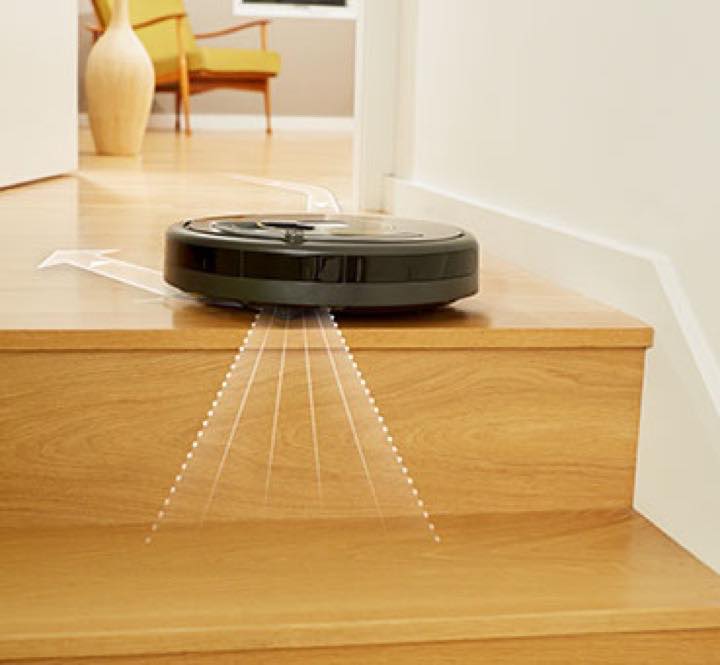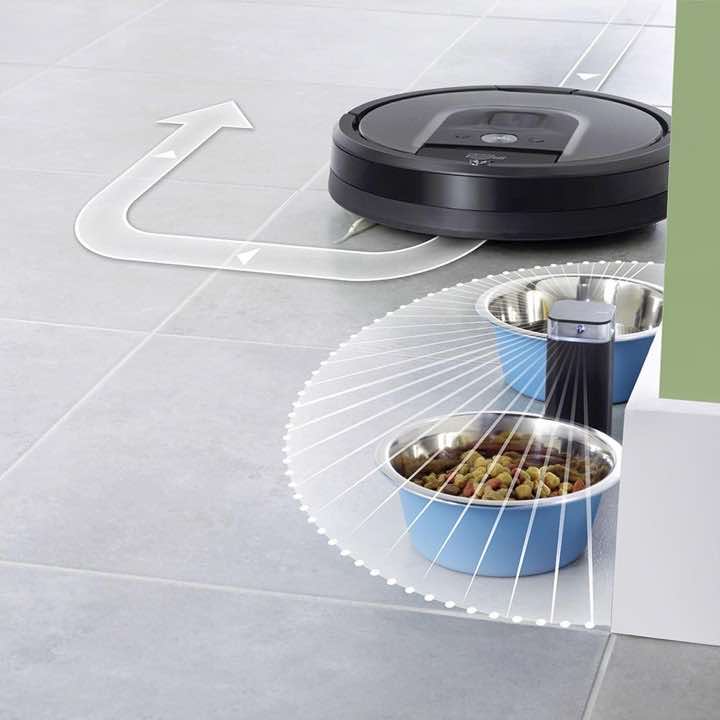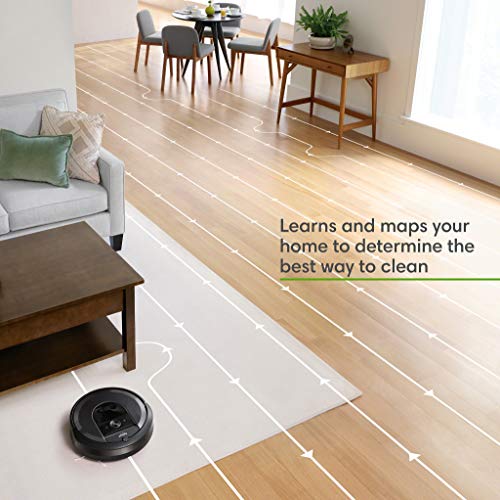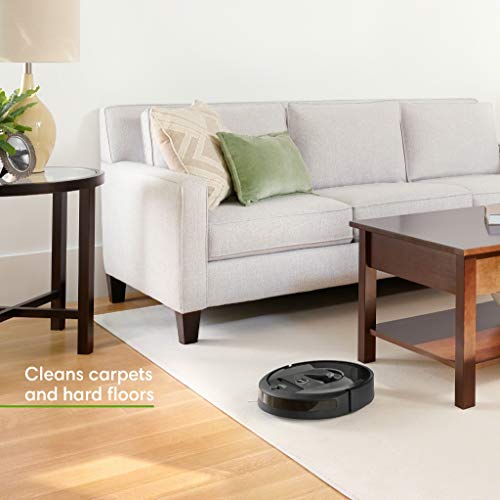iRobot continues to make great Roomba robot vacuums with advanced features at various price points.
We take a look at a couple of iRobot’s best selling Roomba models in the Roomba 960 vs i7. We’ll also discuss the i7+ that’s the same robot vacuum, except it comes with the additional Clean Base unit. Which Roomba is the better option?
In a hurry and just want the answer? The Roomba i7 is the winner and provides the best overall value. But the Roomba 960 isn’t too far behind in terms of value. Read on to find out what we mean.
Features
Size Dimensions
The Roomba 960’s dimensions are 13.8” wide by 3.6” tall with three main buttons on the space grey top panel that control the Roomba vacuum manually. These three buttons are CLEAN, SPOT CLEAN, and HOME, located in the middle of the top panel on a black highlight.
Roomba i7 measures up at 13.34” by 3.63”. It’s a little smaller in width than the Roomba 960 but taller by a tiny fraction.
The design and color scheme of both Roomba models are similar with space gray and black as the main color palettes on both vacuums.
The designs and looks of the 960 and i7 shouldn’t come as much of a surprise as Roombas are all similarly designed, except for the s9, which is D-shaped.
On both Roombas, there is a little protruding knob attached to the front and top of the unit. The piece allows it to gauge whether it’ll be able to fit under a certain height, preventing it from getting stuck under furniture that’s too low.
Weight
The Roomba 960 comes in at a weight of 8.6 lbs and the carrying handle attached on the 960 makes it easy to carry around your home when you need to.
The weight of the Roomba i7 is 7.44lbs – just over a pound lighter than the Roomba 960 – and also features an attached carrying handle.
The i7 will be lighter to carry if you have a multi-story home and need to carry it upstairs and downstairs.
Battery and Capacity
The 2600mAh lithium ion battery on the Roomba 960’s powers it through 75 full minutes of cleaning before needing a recharge.
When the 960’s battery is running low, it’ll look for the home docking station to recharge. When it’s finished recharging in about 3 hours time, the 960 will engage Recharge and Resume.
Recharge and Resume allows the 960 to continue cleaning, picking up from where it stopped cleaning to recharge. It’s a great time-saving, efficiency feature so the 960 won’t be cleaning where it’s already been.
The Roomba i7 has a 3300mAH lithium-ion battery that runs for a fantastic 120 full minutes before needing to be recharged. This amount of runtime is great for bigger homes.
Even though the i7 has a larger battery capacity, it takes the same amount of time as the Roomba 960 to recharge, 3 hours. That’s due to the better-performing charging dock that comes packaged with it.
The Roomba i7 also features the Recharge and Resume function, which is a great extra feature on top of an already great runtime.
Filtration
Both the Roomba 960 and the Roomba i7 features iRobot’s High-Efficiency filters that block out 99% of airborne particles like dust mites, pollen and harmful allergens.
The filters are great for people who’re more susceptible to allergies. With the high-efficiency filter, you can be sure that you and your family are safe from the effects of bad air quality in your home.
Brushes, Suction, and Cleaning Technology
The Roomba 960’s 3-stage cleaning system and it’s 900Pa of suction power allows the 960 to handle any cleaning job you throw at it.
From hardwood to carpet, the Roomba 960 performs well. The dual multi-surface rubber brushes pick up pet hair very well. The rubber brushes also reduce the occurrence of pet hair or human hair getting entangled in the brushroll system – a common gripe amongst robot vacuum owners.
The Roomba i7 also has 10 times the suction power of the Roomba 600 series models and 5x the suction power of the 900 series, including the 960.
The 3-stage cleaning system performance on the Roomba i7 is great too. The extra suction power helps it tackle cleaning on both high pile carpets and hard floors with accuracy and ease.
One more great feature of the Roomba i7 is that it’s quiet. At 62 decibels, the i7 is the 2nd quietest Roomba out there. The quietest Roomba title goes to the Roomba 671. That’s great news for homes with babies or pets!
The Roomba i7 and 960 both have side brushes that’ll also get into those pesky wall edges.
Dirt Detect Technology comes standard on both units too. This nifty little feature is available on both the Roomba 960 and Roomba i7. The tech uses onboard optical and acoustic sensors to find particularly dirtier areas and focuses more of its cleaning efforts on that area until it’s completely clean.
iRobot installed the iAdapt 2.0 navigation system (with vSLAM) on the Roomba 960 as its main navigational software. The sensors and iAdapt 2.0 help to ensure that your Roomba 960 avoids knocking into walls and obstacles while cleaning.
The optical sensors on the Roomba 960 help it to create a virtual map of your home. Once the map is finished rendering, your Roomba robovac refers to it for a more efficient cleaning experience of your home during that session.
One drawback of iAdapt 2.0 is that the map isn’t stored for future cleanings. That means the 960 remaps your home with each new cleaning session. If it’s engaged in Recharge and Resume, that’s still the same, original session, so no new mapping is needed.
iAdapt 3.0 and the Roomba i7 fixes the problem of the forgetful mapping.
The Roomba i7 has the upgraded iAdapt 3.0 navigation and mapping system. It provides a nice increase in the accuracy and navigation of your home. iAdapt 3.0 has all the features of the earlier iAdapt 2.0 software on the Roomba 960, while making them more useful.
The Roomba i7 is able to create floor plans for multiple stories of your home – which you’ll be able to control through the smartphone app. More later on the app.

Both the i7 and 960 have the Cliff Detection system that warns your Roomba if it’s coming too close to a flight of stairs or a big drop. The Roomba will then turn around in the other direction.
Mobile App and Voice Assistant Control
The iRobot HOME smartphone app (iOS and Android versions available) can be used with both the Roomba 960 and the Roomba i7. The app allows you to control functions such as starting and stopping cleaning, scheduling cleaning times and days, and show the Roomba’s cleaning history.
You’ll also be able to view the virtual map it has made of your home and see the mapping progress in real-time through your smartphone. All from anywhere, at any time as long as your Roomba is connected to a WiFi network.
You can also link Amazon Alexa and Google Home to either Roomba for a fully hands-free voice-activated cleaning experience. Simply learn the Roomba commands from your voice assistant and you’re all set to go.
The Roomba i7 and iAdapt 3.0 mapping and navigation system allows for the creation of Keep Out Zones on your phone. You’ll be able to draw areas on the created maps on your app and the Roomba will avoid those areas.
Maintenance
The Roomba 960’s dustbin holds 600mL (21oz) of debris. That’s usually enough dustbin capacity to last a week or so before needing to be emptied out.
The Roomba 960 will stop in the middle of a cleaning job and alert you through the app if the dustbin is full and needs to be emptied out.
Even though it’ll stop and alert you, it’s still a good idea to empty the dustbin out after each cleaning. That’ll help prolong your Roomba for longer.
The Roomba i7’s dustbin is smaller than the 960’s at 300mL. It’ll also notify you when it’s full, so that you can empty it. But the reason why it’s smaller and doesn’t have much effect in having a clean home is due to the Clean Base Unit you get when you upgrade to the Roomba i7 plus.
The Roomba i7 and i7+ are the two models of the i7 series that’s available. The base robot vacuum of both the i7 and i7+ is the same. The difference between the two models is that the i7+ includes the Clean Base unit.
If you purchase self-emptying Clean Base version, your Roomba i7 effectively turns into an i7+. That allows your i7 vacuum self-empty its bin into the Clean Base tower, which holds around 30 full bags of dirt and debris!.
However, self-emptying automation does come with a higher price tag, so do make note of that if budget it a concern. But if you don’t have the budget now, you can still buy the i7 and then buy the Cleaning Base unit separately when you have the money for it.
Some maintenance advice to keep your Roomba cleaning for a longer time includes wiping down the Roomba regularly. You’ll want to keep the electronic contacts from accumulating dust because that’ll cause charging problems.
Don’t forget to clean and change your filters regularly. Also check for hair and debris entanglement on the bottom, the brushrolls, and side wheels of your Roomba.
Additional Features
Every purchase of the Roomba 960 and the Roomba i7 comes with a dual-mode virtual wall device on Amazon as of writing.
The virtual wall barriers use infrared rays to create no-go zones for the Robovac for certain areas and rooms in your home.

There’re two modes with one acting as a wall and the other is Halo mode. Both modes create areas that stop your Roomba from going into. They can be used to protect fragile furniture that you don’t want the Roomba to come close to.
The i7 and iAdapt 3.0 combination also allows for the creation of Keep Out Zones as mentioned earlier.
Price
The Roomba 960 is $100-150 cheaper than the Roomba i7 at the time of writing, depending on the seller. I’ve seen the i7 bring down the gap when there’s a sale on the i7.
Both are a great deal overall for anyone looking for a robot vacuum for their home.
Pros and Cons
Roomba 960:
Pros
- Cleaning performance is great on carpet
- Optical and acoustic sensors make for good mapping and navigation
Cons
- Software is outdated compared to the Roomba i7
Roomba i7 and i7+
Pros
- Superior overall performance, including carpet and hardwood floors
- iAdapt 3.0 allows for use of maps in future cleaning sessions
- Can self-empty with the Clean Base unit (only for the Roomba i7 plus)
Cons
- The Cleaning Base unit adds a higher cost for the self-emptying automation and convenience
Roomba 960 vs i7 Who is Each For?
Roomba 960 : For those who want to have a good, mid-tier robot vacuum that can clean and do everything that a vacuum is supposed to do well.
Roomba i7: Those who have a higher budget for a better-performing and longer running Roomba. The i7+ is good for bigger homes as bigger homes because of its self-emptying capability with the Clean Base unit.
Final Thoughts
In the end with the Roomba i7 vs 960 comparison, the i7 and i7+ are the winners in this matchup. The base i7 model provides more suction power and better mapping and navigation.
If you have a lower budget, the Roomba 960 is a great choice. The 960 doesn’t have the larger suction power and smart features of the i7, but the 960 still provides good bang for your buck.
If you’re looking for more Roomba 960 or Roomba i7 comparison reviews, check out the list below.















